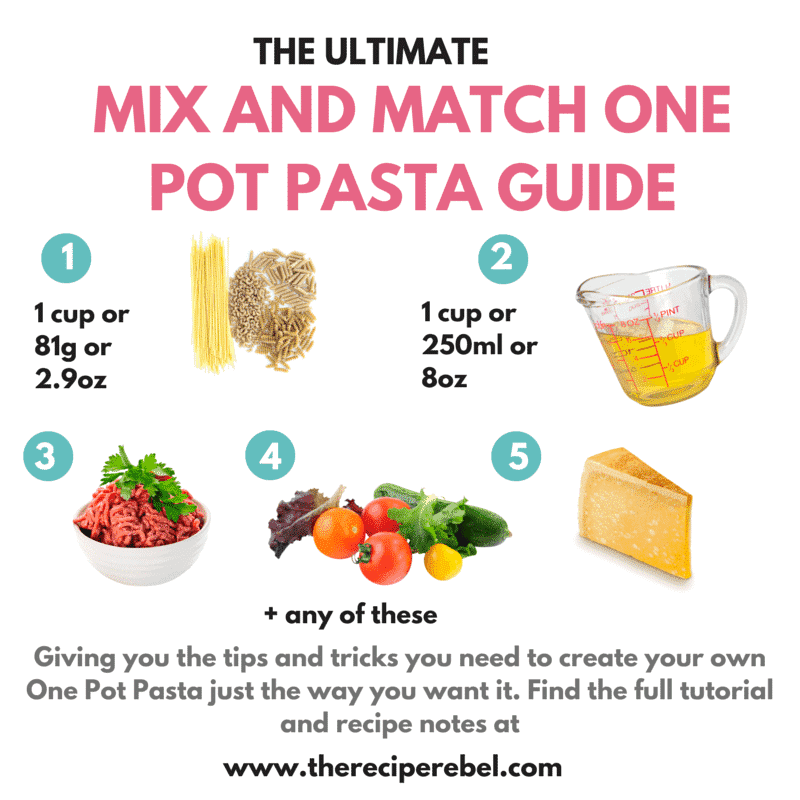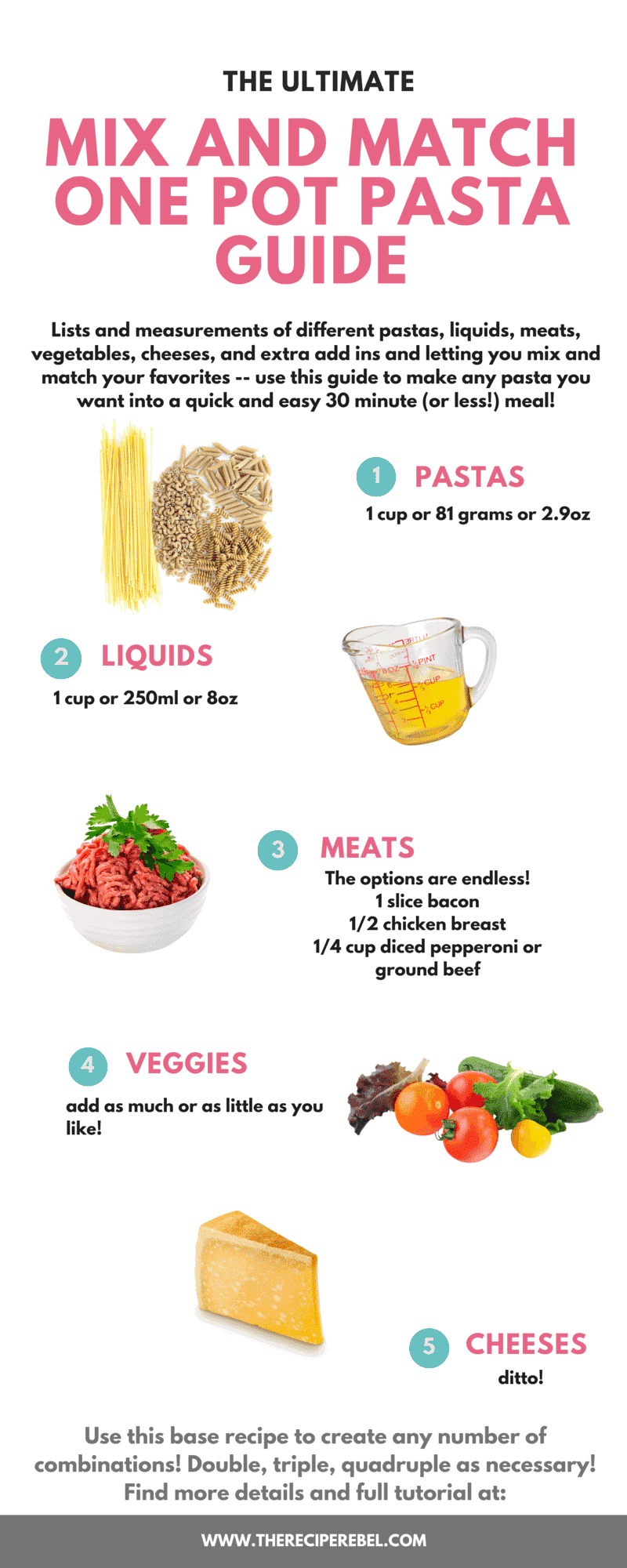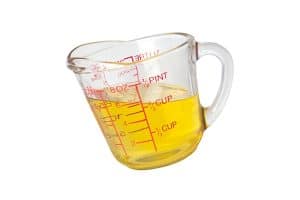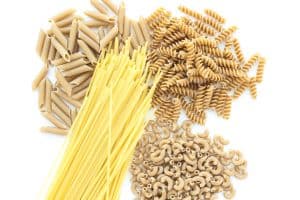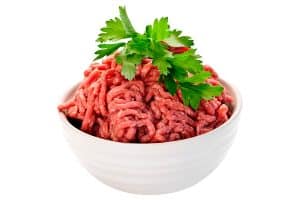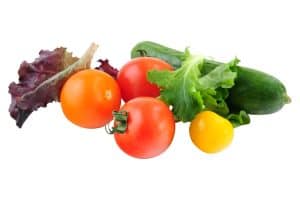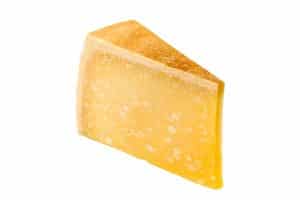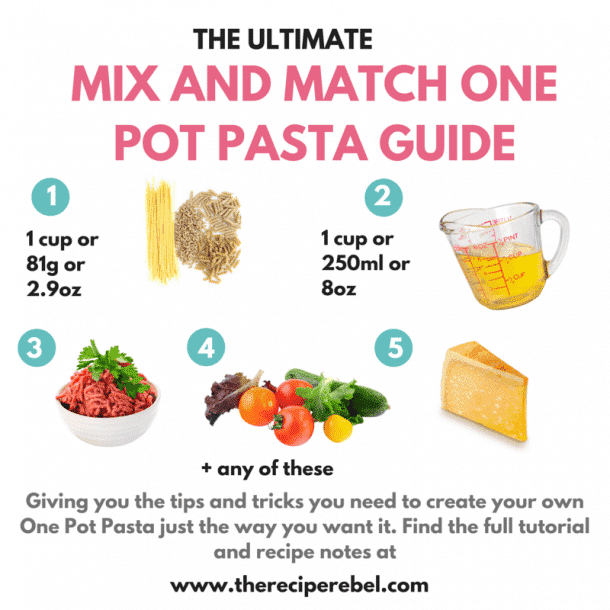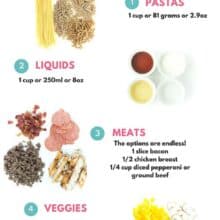I am so excited about this post! I’ve been thinking about doing this for a long time now but I put it off until back to school. September is the time of year everyone needs some great, quick and easy meals! I wanted to create this guide for you because the one pot pasta is my go-to pretty much any day of the week that I wasn’t thinking about making dinner until… yep, right about dinner time. Normally, I’ll start some pasta cooking in any number of a combination of liquids, and then check the fridge to see what I can add in. It is such a great way to customize dinner to your family’s tastes or to use up some of the veggies, cheeses, or meat that has been hanging around in the fridge long enough. I have made countless one pot pastas over the last year, and I use pretty much the same method and measurements every time. Most of these don’t even make it to the blog because, like I said, they are what I make when I’m in a rush and I rarely take the time to photograph them! The only things I really measure are the pasta and the liquid, and the rest can really be done however you like. Adding 1 cooked chicken breast or 4 cooked chicken breasts to your pasta isn’t going to change how much liquid your pasta needs to cook in, or how long it takes — it will just be significantly “meatier”. You can add a lot of veggies or a little veggies or no veggies — this will not change the amount of liquid your pasta needs to cook or how long it takes. You can add a little cheese or a lot of cheese, a little spice or no spice, etc., etc., etc. — I hope you get my point! So the reason I wanted to create this guide is to give you countless easy, 30 minute meals that will help you get through these crazy, busy, chaotic months (we all have those!) — you can take this guide and make Fettucine Alfredo or Spaghetti and Meat Sauce or Chicken Chow Mein or Mac and Cheese. Your options are endless! Some notes on the ingredients: Liquids: These are some liquids I’d recommend, but feel free to get creative!
Water Milk Chicken/Beef/Vegetable Broth Tomato Juice
Most often, I use about half 1% milk and half chicken broth — this keeps things on the lighter side and also gives the pasta tons of flavor and just enough creaminess. The starch from the pasta is going to thicken any liquid you cook it in to some extent, so I don’t find whole milk necessary. I have cooked pasta in all milk before (say for Mac & Cheese) and I actually really prefer doing about half chicken broth because it gives the sauce a smoother consistency and reheats better. Tomato juice would be a great option if you were going to do Spaghetti and Meat Sauce or a Hamburger Helper type of pasta! Pastas Some options:
Macaroni Penne Rotini Small shells Linguine Fettucine Spaghetti Etc. (I mean, really anything)
Some notes: I always, always buy whole wheat or high fiber pasta unless it’s unavailable. You might need a little less water for the same amount of pasta if you’re using regular white pasta, but there shouldn’t be a big difference. I made sure to buy some white pasta to experiment with so I could see the difference and it’s reflected in the recipe below and the recipes to follow. Smaller (thinner) pastas will always less cooking time. Something like a Spaghettini (one of my favorites for Asian dishes!) will not need nearly as much cooking time as say a Penne or Rotini. This is why I give estimates, and cues to look for rather than hard and fast numbers. This is all about experimenting and using what you have and love! Meats Some options (*Instructions for starting with raw meat will also be included in the recipe below):
Deli meats such as pepperoni, cooked ham, beef, turkey, chicken, etc. Cooked, chopped chicken (a rotisserie chicken would be a great shortcut!) Browned ground beef, turkey, chicken or pork Italian sausage, cooked Cooked, crumbled bacon Precooked frozen meatballs
Most of the time, if I’m not using deli meat, I’m starting with raw meat. There is just no point in buying precooked meat unless you are really short on time — it takes only a few extra minutes to cook the meat before adding the pasta. Just cook the meat completely in whichever pot you’re using to cook the pasta (before you add the pasta), and then add your pasta, liquids, and whatever else! There’s no reason at all to cook the meat in a separate pan. I like to cook the meat completely before adding the rest of the ingredients because (a) browned meat tastes better, and the meat is not going to brown if you cook it in the liquid, and (b) it’s just safer. The meat you’re cooking might not have the same cook time as the pasta you’re cooking and you want to make sure that everything is cooked to perfection. Also, leaving the cooked meat in the liquid while the pasta cooks for 10-15 minutes isn’t going to hurt it — it’s not going to get tough or dry out because it’s submersed in liquid, so for me, there’s no reason not to cook it completely beforehand. The Veg Some options:
diced or sliced bell peppers chopped spinach sliced mushrooms snow peas diced tomatoes or cherry tomatoes shredded carrots frozen peas
Cook before: There are some vegetables that you might want to precook before adding the pasta and liquid, but it really depends on how you like them cooked. I find that most vegetables don’t cook completely in the liquid in the time it takes to cook the pasta. If you like some texture in your vegetables, that might be fine with you! If you like them softer, you want want to cook them or par-cook them in the pot first. Vegetables like mushrooms, sliced peppers, sliced/shredded carrots, you might want to cook first. Cook with the pasta: Some vegetables you might want to cook in the liquid with the pasta. Vegetables like tomatoes, peppers (especially if they’re diced or you like more texture to them), shredded carrots, snow peas, would be fine cooked in the liquid with the pasta as they don’t require much cooking time. Add after: If you’re adding frozen vegetables, I generally like to add those and just heat through before serving. There is really no need to cook them and you don’t want the temperature to drop too much as it is cooking the pasta. Chopped spinach I usually add at the end because it only needs to be heated through and wilted. If you are looking for some crunch or texture, you can also add shredded carrots, bell peppers or snow peas near the end of cooking time — it really just depends on how tender you like your vegetables! Cheeses
cheddar mozzarella parmesan blue cheese gruyere etc., etc., etc.!
There are really very few rules with cheese! Add the cheese (whichever you’re using and pretty much however much you want) once the pasta is cooked and stir until melted. The cheese also helps to thicken the sauce if it is a bit thin after cooking time. Extras
tomato/pizza sauce pesto condensed soup (mushroom, tomato) fruit (pineapple, etc.) ketchup sour cream spices salt and pepper
Most “extra” ingredients you can add as much as you want without changing the consistency of the dish substantially. Spices, salt and pepper you will adjust to your tastes. The only things I would add at the beginning of the cooking time are salt, pepper and spices. Spices, salt and pepper you will adjust to your tastes, but I would start with ¼ tsp salt per 1 cup pasta. The extra ingredients that add moisture, like tomato sauce, condensed soup, ketchup or sour cream, I normally limit to 1-2 cups and add them once the pasta is nearly cooked. By the end of the cook time you can see if there is a lot of liquid left or if the pasta has absorbed it all. If the pasta has absorbed all the liquid, you can add more of the extra sauces. If there is still some liquid left in the pan, some of the thicker sauces (tomato sauce, sour cream, etc.) could help to thicken the liquid that’s remaining. My best advice would be to add these extra ingredients at the end of the cooking time, and add them gradually. Taste test as you go, and adjust everything to your tastes! I really just want to give you some tools and tricks to help you get more comfortable experimenting on your own, and creating some quick, tasty dishes with some combinations that might be new to you! TROUBLESHOOTING I wanted to include a section on trouble shooting some problems you might encounter so you know how to handle any curves that might come your way. Mainly, there are 2 issues you might have when making your own One Pot Pasta recipe: too much liquid and too little liquid. Too much liquid If your pasta is fully cooked and your pasta is still soupy, try these things:
Half way through cooking, if it looks like there will be too much liquid, remove the lid and cook uncovered (if you had it covered) Stir in cheese to help thicken the sauce Combine equal parts corn starch and water (start small with just 1-2 tsp of each) and stir into pasta The sauce will continue to thicken as it sits (even without these extra measures): cover with a lid, remove from heat and let sit 5 minutes before serving
Too little liquid If you’re not through the cooking time and your pasta is too dry and not fully cooked:
add more liquid! Think of it like a risotto, which you add liquid to as its cooking, and keep adding liquid until it’s cooked — the same technique works here! Technically, you should use hot liquid so it doesn’t bring down the temperature. I actually don’t (I’m a rebel), I just add room temperature liquid and I added it slowly, stirring, so it doesn’t bring down the temperature too much.
SAMPLE RECIPES Here are 4 sample recipes using my formula above. One Pot Green Chile Mac & Cheese One Pot Pepperoni Pizza Mac & Cheese with Bacon One Pot Pasta Primavera One Pot Chicken Chow Mein *This post contains affiliate links — I get a miniscule percentage if you purchase something through my page, and it helps me continue to put out great content! Create an account easily save your favorite content, so you never forget a recipe again. Register Now Tag @thereciperebel or hashtag #thereciperebel — I love to see what you’re making!
